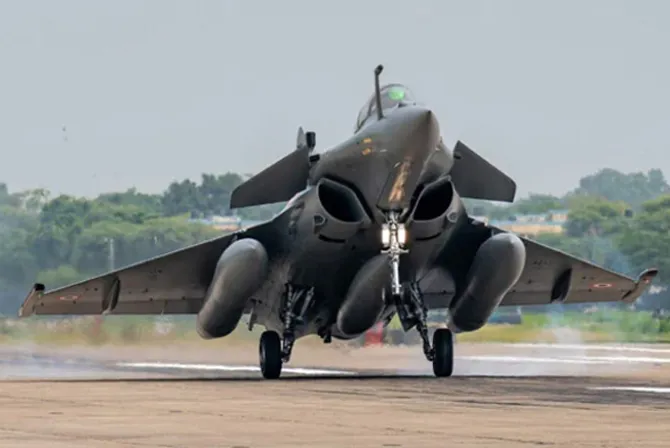-
CENTRES
Progammes & Centres
Location
With theaterisation taking place in defence, the time is ripe to tap into the potential of space for India’s defence requirements

Observation, position, and communication are the three prime attributes of warfare to fight any military operation—from tactical battle to strategic war across domains. Space, owing to its unique specifications, has emerged the most promising force-multiplier overriding acute limitations of land, sea and air-based platforms in provisioning global coverage, persistent surveillance, uninterrupted communications, rapid response, global navigation and multimodal integration. With its advent in the terminal phase of WWII in 1945 when desperate Germans fired the re-entrant V2 rockets over the French and British, space today offers a plethora of opportunities to enhance defence capabilities as the ultimate contrivance of modern warfare. The need for establishing coherence in existing military space capability, and the optimal exploitation of future space technology solutions, to evolve a well-defined architectural roadmap encompassing all possible tangible and intangible attributes cannot be emphasised enough. In addition to a fuller exploitation of the Indian space potential, which involves not just the satellites orbiting in the sky but also an integrated development of the Ground and User segments, there is a need for duly blending the niche technological breakthroughs to arrive at the desired output, collectively generating the intended use for defence during peace and war.
The potential of space for defence usage lies in winning without fighting and, therefore, India needs to enhance its capabilities as well as invest in systems beyond the essential space arena to explore out-of-the-box spin-offs.
Space has been significantly integrated into the defence arena worldwide over the last two decades (even in India, up to some extent). Two distinct spheres, integrated with ‘Space for Security’, are the enhancement of the combat potential of the defence forces through space and the safeguarding of the space assets itself (comprising Space Situational Awareness (SSA) and counter-space operations). Space provides the potential to integrate platforms across land, air, and sea for military operations ranging from conventional warfare, asymmetric threats, and disaster response to out-of-area contingency operations. In a nutshell, it is the space-based C4ISR systems[1], which form the key dominion in boosting the preparedness and effectiveness of the defence forces on the battlefield. Applications of space-based weather forecasting, secure communications, intelligence gathering, round-the-clock surveillance, in-depth reconnaissance, accurate positioning, precise navigation, targeting and missile warning duly integrated with cyberspace and Artificial Intelligence (AI) constitute the power of converting every soldier into a formidable system in war. The potential of space for defence usage lies in winning without fighting and, therefore, India needs to enhance its capabilities as well as invest in systems beyond the essential space arena to explore out-of-the-box spin-offs. Disruptive uses of technologies finding their effective usage in war have evolved, with varying theories on the changing face of future wars. All possible formats of war—from the short-intense conventional to hybrid, network-centric, grey-zone, and the latest in the league, the multi-domain wars—have one thing in common—‘integration of C4ISR systems to shorten the decision-making process’. Today, when other pathbreaking military technologies have well matured, space technology is on the exponential development curve exploring breakthroughs in hypersonic glide vehicles, reusable launch vehicles, in-orbit refuelling and maintenance, co-orbital applications, IoT constellations in LEO, cis-lunar explorations, quantum communications, multi-payload constellations, directed energy weapons and much more, revolutionising military affairs.
Organisations dealing with the utilisation of space for national security need to reappraise the capability development with better inter-agency coordination, effective architectural reforms, reorientation of the outlook, and application in building the phased roadmaps.
Apart from the gaps in various technological capabilities, one of the biggest challenges confronting an emerging space power like India is the integration of space and exploitation of joint C4ISR systems into a cohesive whole. Organisations dealing with the utilisation of space for national security need to reappraise the capability development with better inter-agency coordination, effective architectural reforms, reorientation of the outlook, and application in building the phased roadmaps.
Since the mark of the space age with the placement of the first surveillance satellite into the Earth’s orbit by Russia in 1957, the military intent in all of the subsequent launches by the major space-faring nations (United States (US), Russia, and China), was clear and unambiguous, unlike India, which launched Rohini-I in 1980 as its first dual-use satellite for Earth observation. India has 64 operational satellites in orbit out of 115 assets launched, with its first asset launched in 1975. While the Indian Space Research Organisation (ISRO) claimed the sixth slot in a global quantitative space order, China surpassed Russia—the then number two—in 2018 and operates a whopping 645 operational satellites against Russia’s 230. China’s claim to fame is an endless and overwhelming list, comprising a number of milestones including unique technology demonstrations of all kinds including offensive and defensive space warfare capability (hard and soft kills); series of Earth observation constellations like Yaogan, Gaofen, Jilin, Shiyan, Jiangbing for military applications; ‘Micius’, the only quantum communication satellite in the world; Global Navigation Satellite System (GNSS) ‘Beidou’ (quantitatively and qualitatively heavier than GPS); air, sea and land launch platforms; a nearly completed Chinese space station; cis-lunar exploration programme of International Lunar Research Station (ILRS, a Russia-China collaborative rival to the US Artemis Accord) and so on.
China’s annual launches since 2020 are almost equal to the total number of operational space assets held by India.
India and China, which commenced their space programmes almost at the same time in the 1960s, are not at parity today, both in a qualitative and quantitative measurement. China’s annual launches since 2020 are almost equal to the total number of operational space assets held by India. By acquiring the enormous capability of scanning every inch of the globe in less than every 10 minutes; sub-centimeteric targeting precision of Positioning, Navigation and Timing (PNT) data; unwavering quantum technology encryptions against jamming and spoofing attacks, China is beating its own PDCs[2] and standards hands down and, hence, is a cause of concern for India. The minimum exponential parity coefficient in space stats between the two rivals today is ‘10 times’, be it the annual budget or launches or even the research, training, academic facilities, private sector engagements or show of might with space demonstrations.
India has adequately tapped the potential of space technology in civil uses and celestial probes, but it remains heavily unoptimised when it comes to national security. Other than the budget which, of course, remained the primary constraint, the approach to utilising space optimally for defence applications also suffered setbacks. Primarily, the approach had been reactive and supportive; firstly, to meet the hoarse and bare minimum needs of defence piecemeal and, secondly, just to keep the ageing assets/ efforts alive. While the above-stated approach has not yielded optimal utilisation of space for defence, it is found reasonably justified keeping the national socio-economic and security conditions in consideration over the years. However, it has been seen that the emphasis on capacity building for defence through space had mostly been a reactionary measure subsequent to external security threats. For instance, it is not coincidental that NavIC (navigation by Indian constellation), the PNT Restricted Service (RS) project, and the strategic Space-Based Surveillance (SBS) programme kickstarted only in the aftermath of the Kargil Crisis. The same is the case with the RISAT satellite. While both the dual-use projects are active and operating, the effective applications for strategic usage are suffering from a lack of quality end-products and the long gestation periods in the co-development of user and space segments. Taking a cue from this crisis-driven approach, there is a critical need for comprehensive planning in terms of defence space policy guidelines, doctrine, strategy, organisational architecture, technical support and infrastructure.
India also raised its own Defence Space Agency under HQ Integrated Defence Staff (HQ IDS), and its technical counterpart, The Directorate of Special Projects under Defence Research and Development Organisation (DRDO) in October 2018 and operationalised the same in June 2019.
Recent military developments in the utilisation of space for defence show that major space-faring nations have raised/graduated their defence space organisations in the last five to seven years. The Russian Aerospace Forces (2015), the Chinese Strategic Support Force (2016), the US Space Force (2019), the French Space Command (2019), the UK Space Command (2021) and Australian Defence Space Command (2022) are examples. Acknowledging this need, India also raised its own Defence Space Agency under HQ Integrated Defence Staff (HQ IDS), and its technical counterpart, The Directorate of Special Projects under Defence Research and Development Organisation (DRDO) in October 2018 and operationalised the same in June 2019. While these up the ante with a clear seriousness to develop the defence space sector along with opening up to the private space industry in 2020, the desired end-state needs to be well-defined and orchestrated to reap the optimum benefits. To tap the optimal potential of space capabilities for defence, there is an immediate need to put a multi-pronged strategy in place to bring in relevant changes in the conventional approach, blurred policies, and missing architectures and roadmaps. India’s space exploitation must evolve to meet the challenges and seize the opportunities in the defence space domain. By embracing attributes such as resilience, interoperability, and flexibility, India can optimise its defence space architecture to ensure effectiveness, responsiveness, and endurance. Collaborating with allies and commercial entities can further enhance India's space capabilities and support national security objectives. As India develops and expands its space enterprise, it can capitalise on the advancements of the commercial space economy to achieve success in the rapidly maturing space domain. With theaterisation happening now in defence, the time is ripe for tapping into the potential of space for India’s defence requirements.
Colonel Balak Singh Verma, VSM, is an Army Air Defence officer, commissioned into a Schilka regiment in 1997 from IMA.
[1] C4ISR is an acronym that stands for Command, Control, Communications, Computers, Intelligence, Surveillance, and Reconnaissance. This term is commonly used in military and defence contexts to refer to integrated systems and technologies that support various aspects of military operations, including decision-making, communication, data analysis, and situational awareness. These systems are essential for coordinating and conducting military activities efficiently and effectively. [2] Probable Date of Completion
The views expressed above belong to the author(s). ORF research and analyses now available on Telegram! Click here to access our curated content — blogs, longforms and interviews.

Colonel Balak Singh Verma, VSM, is an Army Air Defence officer, commissioned into a Schilka regiment in 1997 from IMA. Having served in North and ...
Read More +